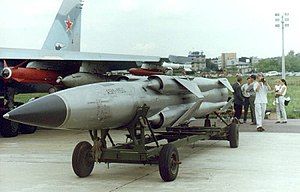Cruise Missile
MoskitIndia has most probably bought both land and ship variants which have a range of 120 km. India bought around 200 Klub missiles and now it is believed that the Moskit have been kept in reserve but can still be used.
| Moskit | |
|---|---|
 | |
| Type | Anti-ship missile |
| Production history | |
| Manufacturer | MKB Raduga |
| Specifications | |
| Weight | 4,500 kg |
| Length | 9.745 m |
| Diameter | 0.8 m |
| Warhead | 320 kg high explosive or 120 kt of TNT fission-fusion thermonuclear |
| Engine | Four ramjets (solid fuel rocket on air-to-surface version) |
| Wingspan | 2.10 m |
| Operational range | 120 km |
| Flight altitude | 20 m above sea level |
| Speed | Mach 2.5 |
| Guidance system | active radar |
| Launch platform | naval ships, fixed-wing aircraft |
The P-270 Moskit (Russian: П-270 «Москит»; English: Mosquito) is a Russian supersonic ramjet powered cruise missile. Its GRAU designation is 3M80, and its NATO reporting name is SS-N-22 Sunburn. The missile system was designed by the Raduga Design Bureau during the 1970s as a follow up to the SS-N-9 "Siren". The Moskit was originally designed to be ship launched, but variants have been adapted to be launched from land (modified trucks), underwater (submarines) and air (reportedly the Sukhoi Su-33, a naval variant of the Sukhoi Su-27). The missile can carry conventional and nuclear warheads.
The exact classification of the missile is unknown, with varying types reported; this has been due to the secrecy surrounding an active military weapon. It is one of the missiles known by the NATO codename SS-N-22 Sunburn. It reaches Mach 3 at a high altitude and its maximum low-altitude speed is M2.2, triple the speed of the subsonic American Harpoon. When such slower missiles, like the Harpoon or the French Exocet are used, the maximum theoretical response time for the defending ship is 120-150 seconds. This provides time to launch countermeasures and employ jamming before deploying "hard" defense tactics such as launching missiles and using quick-firing artillery. But the 3M82 "Mosquito" missiles are extremely fast and give the defending side a maximum theoretical response time of merely 25-30 seconds, rendering it extremely difficult to employ jamming and countermeasures, let alone fire missiles and quick-firing artillery. The Moskit was designed to be employed against smaller NATO naval groups in the Baltic Sea (Danish and German) and the Black Sea (Turkish) and non-NATO vessels in the Pacific (Japanese, South Korean, etc.), and to defend the Russian mainland against NATO amphibious assaultThe missile has been purchased by the People's Liberation Army Navy (China), and reported to be purchased by Iran.

No comments:
Post a Comment